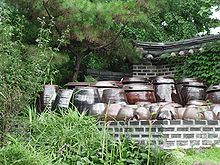- Onggi
-
Onggi 
Korean name Hangul 옹기 Hanja 甕器 Revised Romanization onggi McCune–Reischauer onggi Onggi are Korean ethnic earthenware, which were extensively used as tableware as well as storage containers in Korea. It includes both unglazed earthenware fired near 600~700°C and pottery with a dark brown glaze that burnt over 1100°C.
The origin of onggi dates to approximately 4000 to 5000 BC.[1] There were two types of earthenware: a patternless earthenware which is called Mumun pottery and a black and red earthenware. The former, a patternless earthenware, was made with lumps of clay including much fine sand; however, the predecessor of Goryeo celadon and Joseon white porcelain, a black/red earthenware, was being made with only lumps of clay. The color of earthenware is determined by the iron contained in the mud and the way of burning the pottery. The present onggi shape dates from the Joseon era. There are many records about onggi in Sejong Sillok Jiriji (세종실록지리지, King Sejong's Treatise on Geography): "There are three kilns that make the yellow onggi in Chogye-gun and Jinju-mok, Gyeongsang Province" (Lee and Jeong, 16).
Contents
Usages
Compared to porcelain, onggi has a microporous structure and has been found to assist in the fermentation of Korean fermented foods such as gochujang (chili pepper paste), doenjang (soybean paste) and soy sauce. Onggi with proper porosity and permeability needs to be used in order to produce an optimally ripened quality in fermented foodstuff. Fine tuned onggi containers are, in fact, suitable for many different kinds of fermented products.[2] Since early times, Korea has been famous for fermented foods. In ancient Chinese historiography, in the chapter on Dongyi (烏丸鮮卑東夷傳) in the Records of Wei (魏志), which is part of the Records of the Three Kingdoms (三國志), there is this remark: "Goguryeo people have a custom of making fermented foods" (Lee and Jeong, 100). The abundance of soybean, which grows naturally in Korea, the fresh fishery resources from the sea surrounding the Korean peninsula and a proper climate for microbial development, all give account of the importance of fermentation as food processing. However, onggi ware also contributed to the development of fermented dishes within Korean cuisine.
Features
Onggi, made by a specialized group of workmen called onggijang (옹기장), has been influenced by the characteristics and climate of the regions where it has been made. Therefore, there are shapes and sizes of onggi and ways of manufacturing it that vary from region to region (Jeong, 138). Nevertheless, all onggi types share some properties. These are biodegradability, porosity, and rotproofness as well as firmness or "vertebration" (Jeong, 132).
Decomposition, the Biodegradable Nature of Onggi
When onggi is chipped or broken into bits, it decomposes into earth. That is why it is difficult to find old shards of onggi.
Porosity
While burning onggi, the onggijang master glazes its surface. This glaze plays a key role in giving a waterproof surface and preventing leaks. Following up, many particles of sand are included in the body of the clay acting as passages for air. This way, air can move through onggi while water cannot. Koreans call this action, "onggi drawing breath." This is one of the most critical reasons to use onggi in making Korean fermented foods. As time goes by, the surface of onggi containing fermented food becomes sticky because the toxines of food tend to come out.
Rotproofness
The carbon and smoke which occur when firing wood as a fuel in the kiln adheres to the whole surface of onggi, making it a rotproof material for foods. This works together with the glaze, which also prevents the decomposition of food contained within.
Vertebration
Onggi has one strong advantage over other containers: it is not affected by use or natural phenomena. In fact, onggi can withstand exposure to strong sunshine and rain for a long time.
See also
References
- ^ Moon Yongrin 문용린 and Oh Hyeonseok 오현석, "A study on the actual state of scarce resources and the extinctive process," Gyoyuk Gwahak Gisulbu 교육부 [Ministry of Education, Science and Technology], 2004), 74-91.
- ^ Changwon Jeonmun Daehak 창원전문대학 [Changwon College], "Balhyosikpumui pumjire michineun onggiui mulseongpyeongga" 발효식품의 품질에 미치는 옹기의 물성평가 [Property evaluation of onggi on the quality of fermented food] (Nongnimbu, 2004): 7, 39-64.
- "Ilbanjeok teugiseong" 일반적 특이성 [General characteristics]. Onggi Maeul 옹기 마을 [Onggi village]. June 27, 2008. <http://pottery97.com.ne.kr>.
- Jeong Byeongrak. "Conversation with Onggi." Dongkwang publisher. 1998
- Lee Hoonseok and Jeong Yangmo. "Onggi" Dae-won-sa. 1993
External links
Categories:- Korean pottery
Wikimedia Foundation. 2010.
